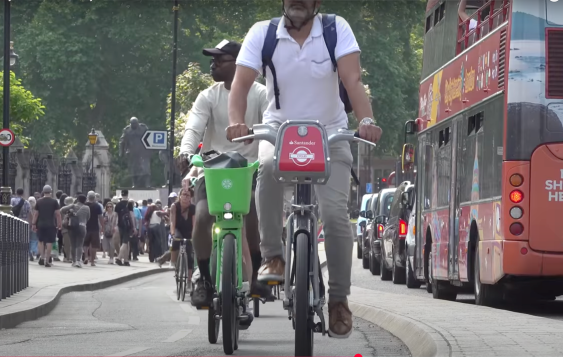 A sign in Sausalito that contradicts state law. Photos: Joshua Hart.
A sign in Sausalito that contradicts state law. Photos: Joshua Hart. While Marin County has been designated a "national model" for bicycling and walking, one of four counties that have received a $25 million grant from the Federal Nonmotorized Transportation Pilot Program (NTPP), Sausalito has been notably hostile to the influx of cyclists who come over the Golden Gate Bridge, particularly tourists who rent bicycles in San Francisco.
According to David Hoffman, Director of Planning for the Marin County Bicycle Coalition (MCBC), "over the last several months, some elements -- coming from both citizens and city leadership -- have suggested removing all bicycle parking racks in the town, proposed to 'truck cyclists out of town' and are opposing planned future improvements to cycling facilities."
What's worse, the city of Sausalito recently installed a number of signs along Bridgeway that contradict California Vehicle Code (CVC) Section 21202 and tell cyclists that they "must ride single file in bike lane" and ride "single file on roadway" when passing through the town. In fact, the CVC allows cyclists to ride in the middle of a narrow lane, does not explicitly prohibit riding side by side, and allows cyclists to leave the bike lane under a number of circumstances.
According to Dan Gutierrez, Policy Chair of the Caltrans District 7 Bicycle Advisory Committee, this is a case of improper, non-standard signage. "The CVC does not require that bicyclists must only ride in bike lanes, since a bicyclist moving at the speed of traffic or faster may use a travel lane, and even those moving slower may still leave the lane when passing other drivers, preparing for a left turn, avoiding hazards (such as the door zone), and when approaching places where right turns are authorized [like driveways and intersections]."
So is Sausalito making up its own traffic laws?
 After the descent from the Golden Gate Bridge into Sausalito, cyclists are welcomed with improper signs on trash cans.
After the descent from the Golden Gate Bridge into Sausalito, cyclists are welcomed with improper signs on trash cans. City Engineer Todd Teachout said the new signs are not anti-cyclist but are part of a strategy to deal with bicycle traffic. Teachout said that over the last three years "the city has been grappling with a large and increasing influx of not-so-skilled cyclists on city roads." He added, "the signs in question are advisory, not regulatory."
The signs, however, are black and white, the standard for a traffic regulation, and give the impression that they are law.
Jim Baross, president of the California Association of Bicycling Organizations (CABO), said, "There are supposed to be standardized rules for behavior, traffic signs, and roadway markings all across the State of California. Our safety and lives are put at risk when cities 'go rogue' with traffic operation."
According to Hoffman of the MCBC, the signs were authorized directly by the City Council, without being vetted by the Police Department or Public Works. Both agencies are now reviewing the legality of the new signage in light of questions posed by Streetsblog.
Jason Meggs of the Bicycle Civil Liberties Union is concerned about the potential impacts of Sausalito's actions on the rights of cyclists throughout the Bay Area. "They are sending a message that cyclists are welcome in Sausalito only if they stay out of the way of car drivers."
On a recent sunny day in Sausalito, Streetsblog interviewed cyclists who were waiting for the ferry to return to San Francisco. Sarah Andersen, a woman from Denmark who had rented a bike in San Francisco and pedaled over the bridge, was shocked by the attitude of the city council.
"They should be glad they don't live in Copenhagen because cyclists are everywhere," she said. "They've just got to get used to it -- it's the future after all."
Despite being labelled a "plague of locusts" by some in the city, the economic benefits cyclists bring to Sausalito are hard to dispute. According to MCBC's Hoffman, "Sausalito was the only city in Marin County last year that showed positive sales tax growth. Tourism -- particularly bike-based tourism -- is likely responsible."
The MCBC has been meeting with City officials in an attempt to get the signs removed, though when that could happen is still unclear.
Hoffman, who insisted he would rather spend his time developing the bicycle network in southern Marin County than quibbling over signage, added, "our biggest concern at this point is getting the Council to embrace good bicycle facilities in the town."

 Requiring that cyclists use the bike lane is not always in the interests of safety. As this photo illustrates, the only safe place for a cyclist to ride is well outside the door zone, which means outside of the bike lane.
Requiring that cyclists use the bike lane is not always in the interests of safety. As this photo illustrates, the only safe place for a cyclist to ride is well outside the door zone, which means outside of the bike lane.



